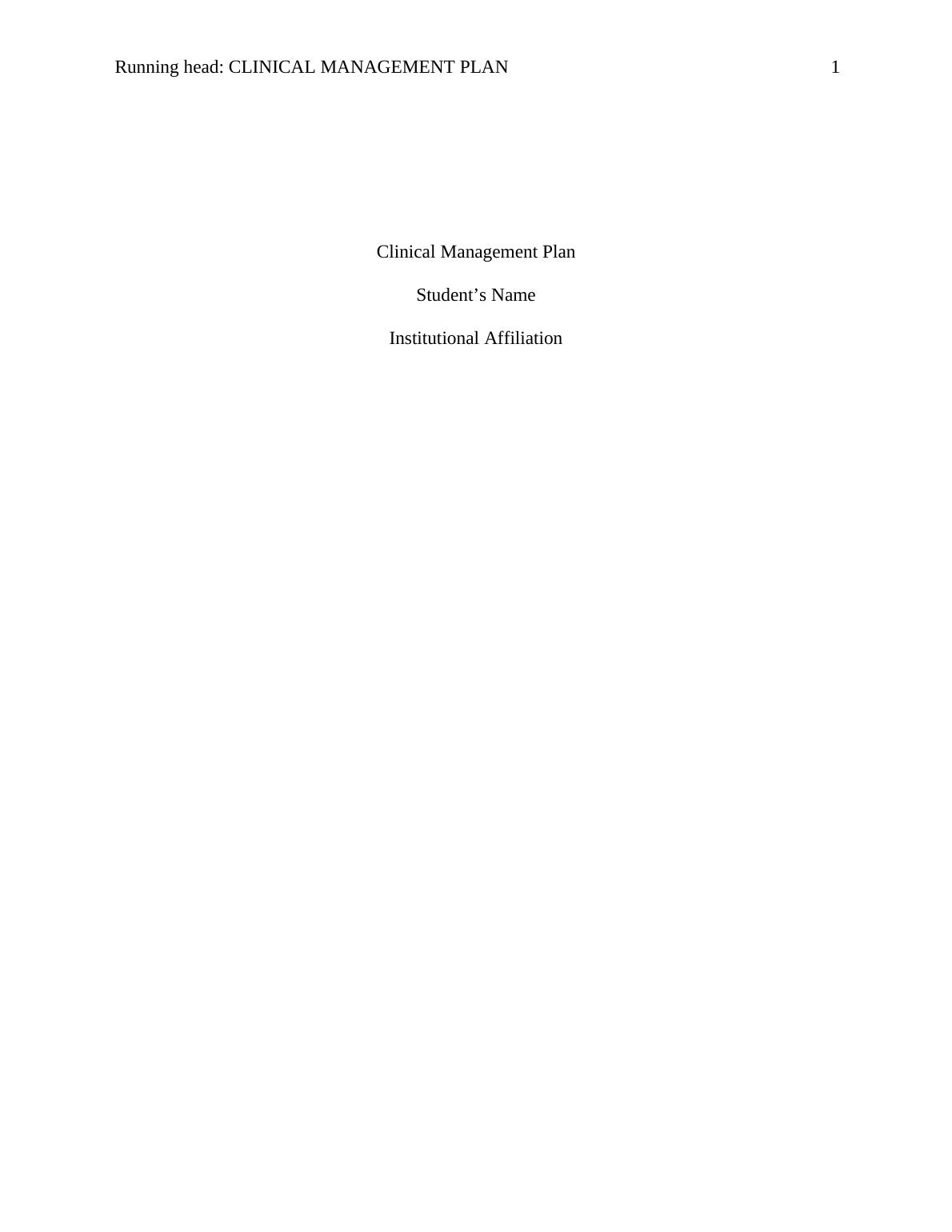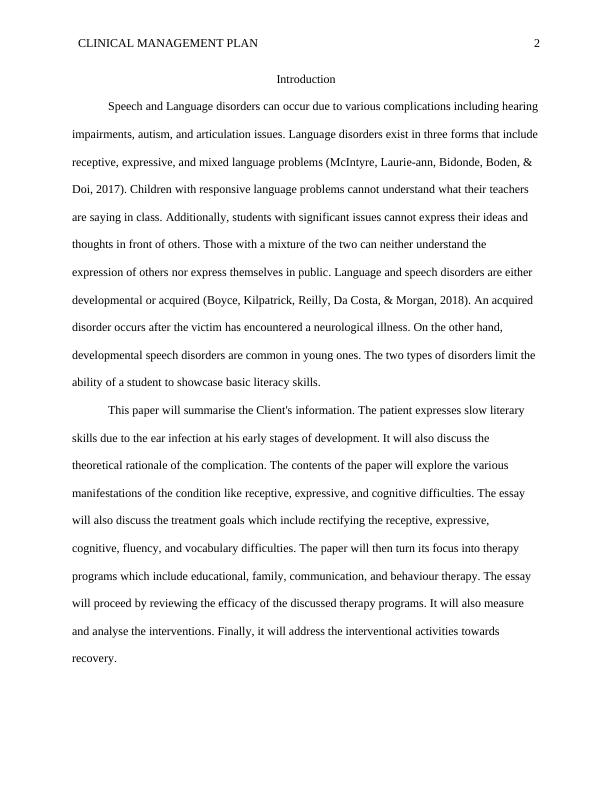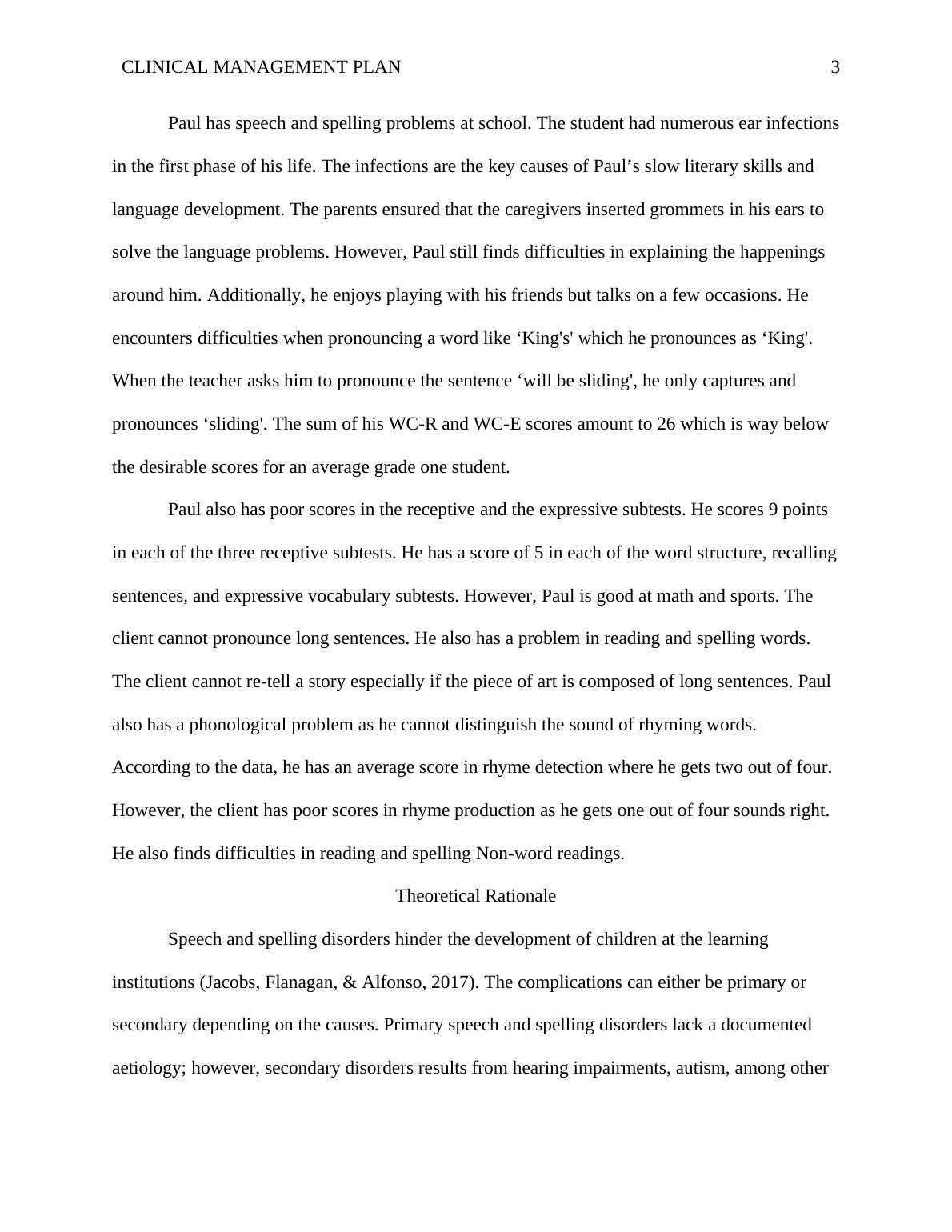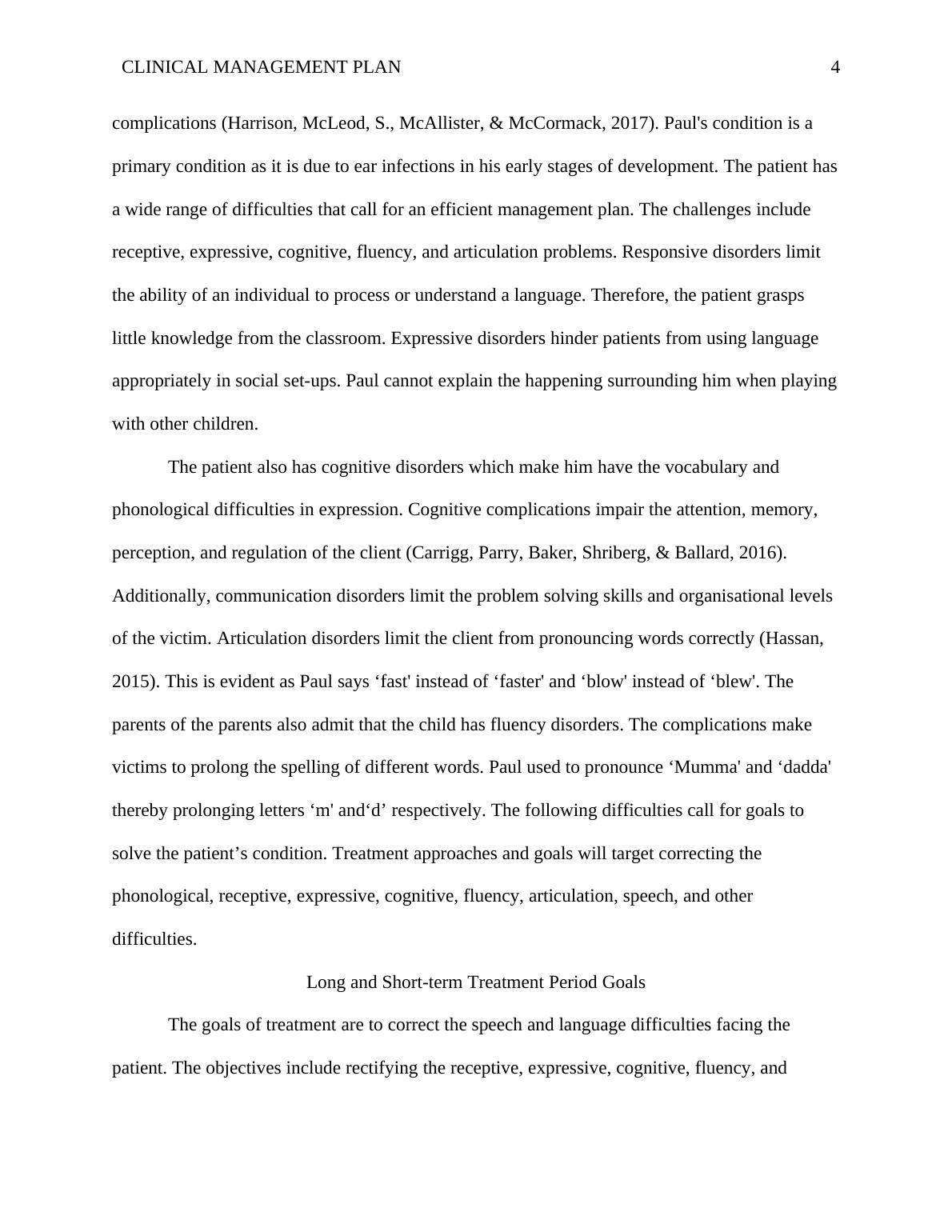Clinical Management Plan PDF
Added on 2021-11-05
13 Pages3962 Words57 Views
Running head: CLINICAL MANAGEMENT PLAN 1
Clinical Management Plan
Student’s Name
Institutional Affiliation
Clinical Management Plan
Student’s Name
Institutional Affiliation

CLINICAL MANAGEMENT PLAN 2
Introduction
Speech and Language disorders can occur due to various complications including hearing
impairments, autism, and articulation issues. Language disorders exist in three forms that include
receptive, expressive, and mixed language problems (McIntyre, Laurie-ann, Bidonde, Boden, &
Doi, 2017). Children with responsive language problems cannot understand what their teachers
are saying in class. Additionally, students with significant issues cannot express their ideas and
thoughts in front of others. Those with a mixture of the two can neither understand the
expression of others nor express themselves in public. Language and speech disorders are either
developmental or acquired (Boyce, Kilpatrick, Reilly, Da Costa, & Morgan, 2018). An acquired
disorder occurs after the victim has encountered a neurological illness. On the other hand,
developmental speech disorders are common in young ones. The two types of disorders limit the
ability of a student to showcase basic literacy skills.
This paper will summarise the Client's information. The patient expresses slow literary
skills due to the ear infection at his early stages of development. It will also discuss the
theoretical rationale of the complication. The contents of the paper will explore the various
manifestations of the condition like receptive, expressive, and cognitive difficulties. The essay
will also discuss the treatment goals which include rectifying the receptive, expressive,
cognitive, fluency, and vocabulary difficulties. The paper will then turn its focus into therapy
programs which include educational, family, communication, and behaviour therapy. The essay
will proceed by reviewing the efficacy of the discussed therapy programs. It will also measure
and analyse the interventions. Finally, it will address the interventional activities towards
recovery.
Introduction
Speech and Language disorders can occur due to various complications including hearing
impairments, autism, and articulation issues. Language disorders exist in three forms that include
receptive, expressive, and mixed language problems (McIntyre, Laurie-ann, Bidonde, Boden, &
Doi, 2017). Children with responsive language problems cannot understand what their teachers
are saying in class. Additionally, students with significant issues cannot express their ideas and
thoughts in front of others. Those with a mixture of the two can neither understand the
expression of others nor express themselves in public. Language and speech disorders are either
developmental or acquired (Boyce, Kilpatrick, Reilly, Da Costa, & Morgan, 2018). An acquired
disorder occurs after the victim has encountered a neurological illness. On the other hand,
developmental speech disorders are common in young ones. The two types of disorders limit the
ability of a student to showcase basic literacy skills.
This paper will summarise the Client's information. The patient expresses slow literary
skills due to the ear infection at his early stages of development. It will also discuss the
theoretical rationale of the complication. The contents of the paper will explore the various
manifestations of the condition like receptive, expressive, and cognitive difficulties. The essay
will also discuss the treatment goals which include rectifying the receptive, expressive,
cognitive, fluency, and vocabulary difficulties. The paper will then turn its focus into therapy
programs which include educational, family, communication, and behaviour therapy. The essay
will proceed by reviewing the efficacy of the discussed therapy programs. It will also measure
and analyse the interventions. Finally, it will address the interventional activities towards
recovery.

CLINICAL MANAGEMENT PLAN 3
Summary of the Client Information
Paul has speech and spelling problems at school. The student had numerous ear infections
in the first phase of his life. The infections are the key causes of Paul’s slow literary skills and
language development. The parents ensured that the caregivers inserted grommets in his ears to
solve the language problems. However, Paul still finds difficulties in explaining the happenings
around him. Additionally, he enjoys playing with his friends but talks on a few occasions. He
encounters difficulties when pronouncing a word like ‘King's' which he pronounces as ‘King'.
When the teacher asks him to pronounce the sentence ‘will be sliding', he only captures and
pronounces ‘sliding'. The sum of his WC-R and WC-E scores amount to 26 which is way below
the desirable scores for an average grade one student.
Paul also has poor scores in the receptive and the expressive subtests. He scores 9 points
in each of the three receptive subtests. He has a score of 5 in each of the word structure, recalling
sentences, and expressive vocabulary subtests. However, Paul is good at math and sports. The
client cannot pronounce long sentences. He also has a problem in reading and spelling words.
The client cannot re-tell a story especially if the piece of art is composed of long sentences. Paul
also has a phonological problem as he cannot distinguish the sound of rhyming words.
According to the data, he has an average score in rhyme detection where he gets two out of four.
However, the client has poor scores in rhyme production as he gets one out of four sounds right.
He also finds difficulties in reading and spelling Non-word readings.
Theoretical Rationale
Speech and spelling disorders hinder the development of children at the learning
institutions (Jacobs, Flanagan, & Alfonso, 2017). The complications can either be primary or
secondary depending on the causes. Primary speech and spelling disorders lack a documented
Summary of the Client Information
Paul has speech and spelling problems at school. The student had numerous ear infections
in the first phase of his life. The infections are the key causes of Paul’s slow literary skills and
language development. The parents ensured that the caregivers inserted grommets in his ears to
solve the language problems. However, Paul still finds difficulties in explaining the happenings
around him. Additionally, he enjoys playing with his friends but talks on a few occasions. He
encounters difficulties when pronouncing a word like ‘King's' which he pronounces as ‘King'.
When the teacher asks him to pronounce the sentence ‘will be sliding', he only captures and
pronounces ‘sliding'. The sum of his WC-R and WC-E scores amount to 26 which is way below
the desirable scores for an average grade one student.
Paul also has poor scores in the receptive and the expressive subtests. He scores 9 points
in each of the three receptive subtests. He has a score of 5 in each of the word structure, recalling
sentences, and expressive vocabulary subtests. However, Paul is good at math and sports. The
client cannot pronounce long sentences. He also has a problem in reading and spelling words.
The client cannot re-tell a story especially if the piece of art is composed of long sentences. Paul
also has a phonological problem as he cannot distinguish the sound of rhyming words.
According to the data, he has an average score in rhyme detection where he gets two out of four.
However, the client has poor scores in rhyme production as he gets one out of four sounds right.
He also finds difficulties in reading and spelling Non-word readings.
Theoretical Rationale
Speech and spelling disorders hinder the development of children at the learning
institutions (Jacobs, Flanagan, & Alfonso, 2017). The complications can either be primary or
secondary depending on the causes. Primary speech and spelling disorders lack a documented

CLINICAL MANAGEMENT PLAN 4
aetiology; however, secondary disorders results from hearing impairments, autism, among other
complications (Harrison, McLeod, S., McAllister, & McCormack, 2017). Paul's condition is a
primary condition as it is due to ear infections in his early stages of development. The patient has
a wide range of difficulties that call for an efficient management plan. The challenges include
receptive, expressive, cognitive, fluency, and articulation problems. Responsive disorders limit
the ability of an individual to process or understand a language. Therefore, the patient grasps
little knowledge from the classroom. Expressive disorders hinder patients from using language
appropriately in social set-ups. Paul cannot explain the happening surrounding him when playing
with other children.
The patient also has cognitive disorders which make him have the vocabulary and
phonological difficulties in expression. Cognitive complications impair the attention, memory,
perception, and regulation of the client (Carrigg, Parry, Baker, Shriberg, & Ballard, 2016).
Additionally, communication disorders limit the problem solving skills and organisational levels
of the victim. Articulation disorders limit the client from pronouncing words correctly (Hassan,
2015). This is evident as Paul says ‘fast' instead of ‘faster' and ‘blow' instead of ‘blew'. The
parents of the parents also admit that the child has fluency disorders. The complications make
victims to prolong the spelling of different words. Paul used to pronounce ‘Mumma' and ‘dadda'
thereby prolonging letters ‘m' and‘d’ respectively. The following difficulties call for goals to
solve the patient’s condition. Treatment approaches and goals will target correcting the
phonological, receptive, expressive, cognitive, fluency, articulation, speech, and other
difficulties.
Long and Short-term Treatment Period Goals
aetiology; however, secondary disorders results from hearing impairments, autism, among other
complications (Harrison, McLeod, S., McAllister, & McCormack, 2017). Paul's condition is a
primary condition as it is due to ear infections in his early stages of development. The patient has
a wide range of difficulties that call for an efficient management plan. The challenges include
receptive, expressive, cognitive, fluency, and articulation problems. Responsive disorders limit
the ability of an individual to process or understand a language. Therefore, the patient grasps
little knowledge from the classroom. Expressive disorders hinder patients from using language
appropriately in social set-ups. Paul cannot explain the happening surrounding him when playing
with other children.
The patient also has cognitive disorders which make him have the vocabulary and
phonological difficulties in expression. Cognitive complications impair the attention, memory,
perception, and regulation of the client (Carrigg, Parry, Baker, Shriberg, & Ballard, 2016).
Additionally, communication disorders limit the problem solving skills and organisational levels
of the victim. Articulation disorders limit the client from pronouncing words correctly (Hassan,
2015). This is evident as Paul says ‘fast' instead of ‘faster' and ‘blow' instead of ‘blew'. The
parents of the parents also admit that the child has fluency disorders. The complications make
victims to prolong the spelling of different words. Paul used to pronounce ‘Mumma' and ‘dadda'
thereby prolonging letters ‘m' and‘d’ respectively. The following difficulties call for goals to
solve the patient’s condition. Treatment approaches and goals will target correcting the
phonological, receptive, expressive, cognitive, fluency, articulation, speech, and other
difficulties.
Long and Short-term Treatment Period Goals

End of preview
Want to access all the pages? Upload your documents or become a member.
Related Documents
Clinical Management Plan and Session Plan for Joe.lg...
|15
|3957
|3
SPTH2002 Child Language & Hearing Across the Lifespan Languagelg...
|13
|3270
|159
Assignment on Speech Pathologylg...
|11
|2520
|38
